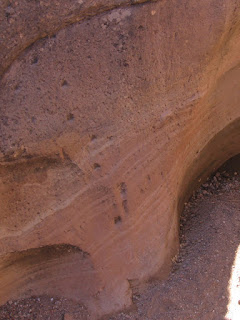On Sunday morning, my friend John Sasso, my dog Scout and I hiked the Rough Canyon trail south of town, in the Bangs Canyon area off Little Park Road. Scout and I tried to do the same hike last summer, but we were forced to turn around due to wet conditions and some difficult scrambling that I felt was beyond Scout's safety level. We didn't experience the same trouble this time. After our mild winter and extremely dry spring, the going was much easier.
I showed John the petroglyphs that Scout and I had found on a canyon wall the last time, and I was angered to see even more graffiti had been added, some of it practically on top of the ancient rock art. John had done a number of rock climbs in the canyon, and he pointed them out as we worked our way down the canyon's stream bed. Scout made a number of athletic moves through the scrambling sections and rewarded himself with quick swims in the many muddy pools.
We eventually reached Rough Canyon Falls, where Scout and I had searched for the elusive moqui steps (sometimes spelled moki steps) during a hike last summer that brought us to the falls from the rim trail that runs above and parallel to the Rough Canyon trail. I told John about the moqui steps during our hike and said that I was hoping to find them that day. He walked up to the edge of the cliff next to the dry stone groove of the falls, pointed down and said, "They're right there!" I joined him and couldn't believe it. I had looked at that same wall the year before and seen nothing unusual, but John saw them right away. I must have been expecting something different the last time, because there was no mistaking them this time. I climbed around the two huge cottonwood trunks that are wedged into the falls to get a better angle for some photos. John looked for a way to get down to the bottom where the steps started, but the only way was to use the steps, which was too dangerous to try without the pool below having enough water to break a fall.
Being an avid rock climber, John proposed that we come back another time with a climbing rope and set an anchor using one of the juniper trees on the rim. We could take turns rappelling down to the bottom and then safely climbing the moqui steps back up while on a belay. After giving it some thought, I would guess that the ancient people who carved the moqui steps must have had a hand-woven rope that they used in conjunction with the steps to make it easier to get up and down, especially if they were carrying water containers. The fact that the first step was about four feet above the bottom made me think that the steps were intended to be used when the pool was full of water. During a dry spell, the shaded pool may have been the only local source for fresh water.
This blog is an account of the pursuit of a dream, to sail around the world. It is named after the sailboat that will fulfill that dream one day, Whispering Jesse. If you share the dream, please join me and we'll take the journey together.
For Charlie and Scout
For Charlie and Scout
About Me

- John Lichty
- Savannah,
Georgia, USA
"Go confidently in the direction of your dreams. Live the life you have imagined." --Henry David Thoreau
 Raising Charlie: The Lessons of a Perfect Dog by John Lichty
Raising Charlie: The Lessons of a Perfect Dog by John Lichty
Blog Archive
Followers

Recommended Links
- ATN Sailing Equipment
- ActiveCaptain
- BoatU.S.
- Coconut Grove Sailing Club
- Doyle Sails - Fort Lauderdale
- El Milagro Marina
- John Kretschmer Sailing
- John Vigor's Blog
- Leap Notes
- Noonsite.com
- Notes From Paradise
- Pam Wall, Cruising Consultant
- Practical Sailor
- Project Bluesphere
- Sail Makai
- So Many Beaches
- Windfinder
Tuesday, April 3, 2012
Subscribe to:
Post Comments (Atom)






No comments:
Post a Comment